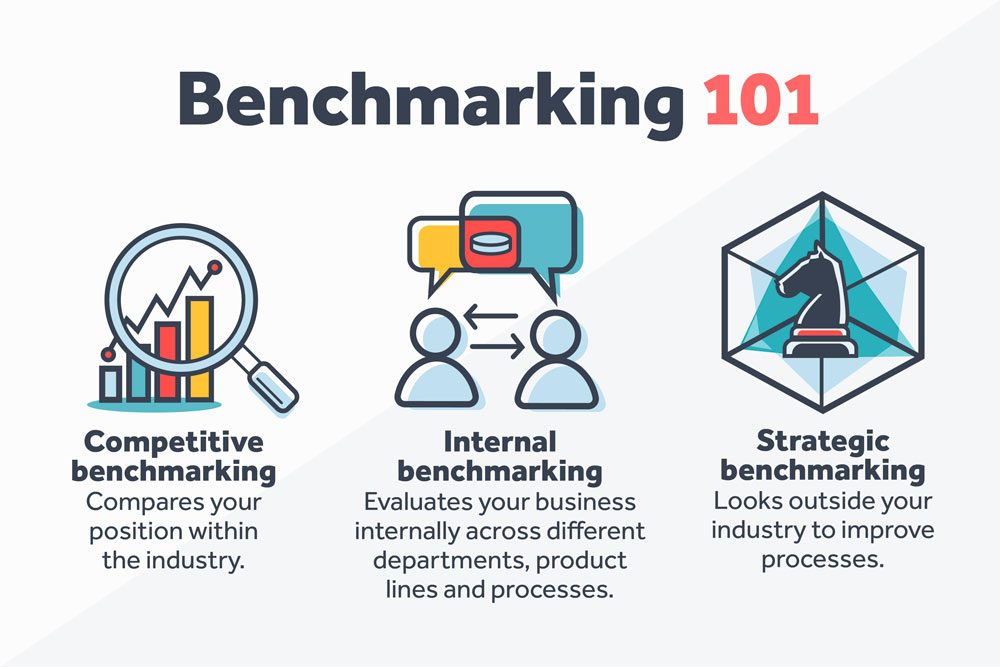In today’s data-driven culture, benchmarking data is a must-have tool—not only for firms, but for clients.
A growing number of firms rely on benchmarking to evaluate where their organizations stand in comparison to other, similar organizations. Firm leaders also use the information internally to improve their team’s performance.
But it shouldn’t stop there. Firms must also pass along the benefits of benchmarking data to their clients by showing them where the client’s business and processes stand in relation to other clients within their industry. Why? Because data is knowledge; knowledge leads to better planning; and better planning leads to success.
Let’s start with the basics of benchmarking, and then we’ll cover the top four reasons firms need to offer benchmarking data to their clients.
Benchmarking 101
In simple terms, benchmarking measures the performance (i.e., quality, time, cost) of a company’s products, services and processes. It’s a tool that allows businesses to compare how they perform internally and externally—not only against competitors, but against other industries as well.

In this article, we’ll consider three types of benchmarking:
- Competitive benchmarking—Compares your position within the industry.
- Internal benchmarking—Evaluates your business internally across different departments, product lines and processes.
- Strategic benchmarking—Looks outside your industry to improve processes.
All three are important for process and performance improvement. You want your clients to grow, improve their processes, increase quality, decrease costs and surpass revenue goals—ultimately gaining a competitive edge.
In addition to improving overall business knowledge, benchmarking promotes employee engagement, connects purpose and culture, and keeps everyone accountable. This leads to optimal performance, improved processes and procedures, and enhanced client satisfaction.
Now, let’s discuss four reasons your firm needs to offer this comparative data to your clients.
Reason #1: Identifies best practices for optimal performance
When you provide clients with benchmarking data, they can identify and implement best practices to improve performance and edge out the competition. But how exactly do they do that?
It starts with KPI (key performance indicators) development. KPIs measure an organization’s success based on strategic goals and objectives. They identify gaps in performance so businesses can make adjustments. And benchmarking provides the baseline that makes the development of KPIs possible.
Reason #2: Improves processes and procedures
When businesses develop KPIs, they’re forced to review past and current processes, exposing gaps in performance. In doing so, they create the opportunity to implement a plan (i.e., set strategic goals) toward improvement.
Rather than rely on the outdated mantra of, “This is how we’ve always done it,” businesses can instead focus on, “How can we do this better?”
Benchmarking gives companies the support they need to start process improvement within their organizations. Leaders can use data from KPIs to inform and train (or re-train) staff to close performance gaps.
As an example, when a company onboards a new employee, instead of introducing the employee to things as they happen (with no processes in place), an employee is given a 90-day onboarding plan with a checklist and timeline of everything they’ll be learning.
Where the lack of a plan can lead to confusion, frustration and even high turnover, having a plan introduces a strategic, streamlined onboarding process so nothing is missed. The employee is onboarded quickly, within a specific time frame, and starts their job with the knowledge they need at their fingertips.
Reason #3: Improves quality and client satisfaction
There’s one particular aspect of a firm where benchmarking not only promotes firm improvement but is also beneficial to clients: Advisory services.
Use the data you already have in your CRM, accounting application or additional reporting tools (e.g., Fathom, Tally Street by Rootworks) to your advantage. Based on the products and services you offer, it’s important to productize services you may currently be providing on a consultative basis (i.e., charging an hourly rate to offer advice on retirement or cash flow management) into value-based, off-the-shelf advisory services.
Offering advisory services improves quality on both sides of the equation. Your firm offers streamlined services tailored to your clients, who benefit from the expert and experienced advice they receive and then use this information to their advantage to improve the quality of their products and services. Your clients can plan and set achievable goals, determine what isn’t working and make necessary adjustments to improve struggling aspects of their business.
Reason #4: Supports peer-to-peer comparisons
To be competitive, businesses need to know where they stand in comparison to other companies within their industry. This knowledge arms them with the information they need in order to make the right adjustments to push past the competition.
Let’s use the restaurant industry as an example. (Keep in mind there will be differences between fast-food restaurants, casual eateries, fine dining establishments, etc.) Below are four benchmarking examples restaurant clients can use to compare where they stand against their peers.
- Workforce. Does hourly compensation for staff stack up to that of other restaurants? What’s the hourly vs. salaried (i.e., management) turnover rate? Do all employees receive healthcare or retirement benefits? Are there enough employees to fully staff shifts?
Some clients may find high turnover due to low pay or non-existent benefits. Knowing how they compare to other restaurants in their city, state or region can help them identify what they should offer in terms of compensation and benefits. And then they’re able to set actionable goals to reach those benchmarks.
- Sales. Based on the restaurant type (i.e., quick-service, full-service, etc.), what are the sales by day, week or month? What amount of revenue is based on food vs. beverage sales? What’s the average amount per check?
Numbers may differ for restaurants that serve alcohol, but they need to know where their sales stand compared to similar restaurants. If sales aren’t up to par, is it due to the cost of materials or underpricing of menu items? This data can help them make better decisions and improve revenue.
- Operations. What percentage of the business is taken up by labor? Is the food cost percentage similar to others? Are inventory items being ordered correctly (e.g., is food going bad due to over-ordering, are shortages affecting inventory)? What percentage of costs are due to overhead?
It’s important to know if there’s waste or insufficient labor to run and manage the restaurant, since neither situation will help revenue. Once business owners understand the gaps, they can fill in where needed to more successfully compete with their peers.
- Customer satisfaction. This is the most important benchmark for any business. Do consumers enjoy what is offered on the current menu? Is service fast and accurate enough? Does the restaurant charge too much based on the quantity and quality of options? And the biggest factor—will customers return?
Everyone has to eat, but a restaurant with no customers isn’t a restaurant. The effect of customers on a restaurant’s success is indisputable. Businesses need to know that customers are satisfied enough to become repeat customers and bring in new business through word of mouth, positive reviews, etc.
When your clients understand their competitor’s success, it can contribute to the success of your clients. Do their competitors have a more efficient seating process for indoor dining? How long does it take from order to food delivery, and can that be improved? In the era of convenience, does offering pickup or delivery services help them to blow past the competition? These questions can all be answered with benchmarking data.
Summary
Providing benchmarking data to your clients is the encouragement they need to be proactive instead of reactive in their industry’s competitive landscape. Benchmarking isn’t a one-and-done deal—it must be done consistently in order to review current processes, adjust goals and objectives, and make improvements to gain a competitive edge.
For more information on how benchmarking and advisory services can help you propel your clients to success, become a Rootworks member today!

